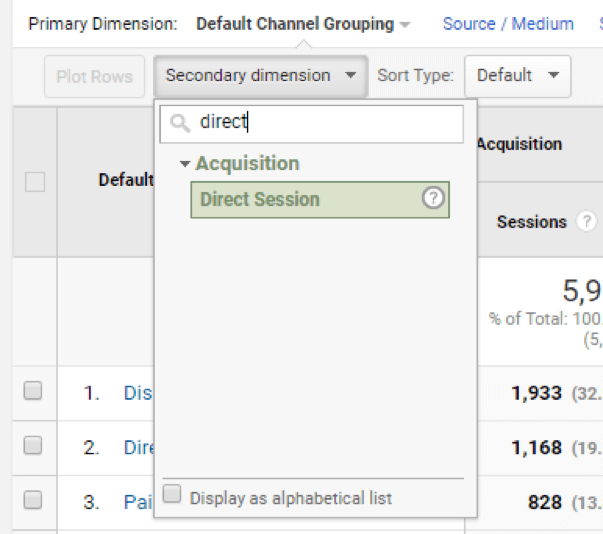How to Utilize Secondary Dimension in Google Analytics for Deeper Insights
How to Utilize Secondary Dimension in Google Analytics for Deeper Insights
Blog Article
Unlock Deeper Insights With Additional Measurement in Google Analytics
With the huge area of data available in Google Analytics, the use of secondary dimensions can considerably improve your analytical abilities. These added layers of information supply a nuanced perspective that can illuminate elaborate information within your primary metrics. By tactically incorporating second dimensions into your analysis, you can discover important understandings that might or else remain obscure. The capacity to dissect and interpret user behavior with higher accuracy opens up a realm of possibilities for enhancing and maximizing methods efficiency.
Recognizing Main Vs. Secondary Measurements
When evaluating data in Google Analytics, it is vital to compare additional and key measurements to get deeper insights into individual behavior. Key dimensions are the main categories by which you can see your data, such as touchdown, tool, or source/medium page. These dimensions give the basic structure for arranging and recognizing your data. On the other hand, second measurements allow you to additional study your key measurement data. By including an additional measurement, you can layer on extra information to your primary measurement, allowing a more granular analysis. If your primary measurement is the source/medium with which users got here on your website, including a secondary dimension like geographical area can reveal where those users are situated geographically. When looking at the primary measurement alone, this included layer of information can help you recognize patterns, patterns, or abnormalities that might not have actually been noticeable. Consequently, leveraging both second and main measurements in Google Analytics is vital for comprehensive data analysis and informed decision-making.
Making Use Of Second Measurements Successfully
By incorporating additional measurements along with primary dimensions, online marketers and analysts can delve deeper right into the specifics of customer interactions on their websites. Second measurements enable users to segment and filter primary dimension data better, supplying a much more comprehensive sight of individual habits, communications, and demographics.
In addition, second measurements make it possible for users to compare and contrast different data factors within a solitary report, facilitating a much more extensive analysis of user actions patterns. By leveraging additional measurements efficiently, organizations can discover hidden understandings, enhance their advertising and marketing approaches, and enhance the total customer experience on their sites.
Checking Out Common Additional Measurement Mixes
To better evaluate user habits and patterns in Google Analytics, it is valuable to discover typical combinations of additional measurements. Some usual additional dimension combinations that give valuable understandings consist of assessing traffic resources with user locations to comprehend where internet site visitors are coming from geographically and how they discovered the website. Checking out user habits metrics with secondary measurements such as interests or demographics can help in targeting certain target market segments a lot more successfully.
Applying Secondary Dimension in Custom-made Reports
Utilizing secondary measurements in custom-made reports enables an extra extensive evaluation of information in Google Analytics, improving the depth of understandings acquired. When producing customized reports in Google Analytics, incorporating additional measurements can provide a much more thorough sight of how numerous measurements connect with each various other. This function enables users to dig much deeper right into their data and reveal useful correlations that might not be right away evident.
By applying additional measurements in personalized records, individuals can acquire a far better understanding of their site or application why not try these out website traffic. As an example, integrating the key dimension of "source/medium" with the secondary measurement of "touchdown page" can expose which landing web pages are carrying out best for traffic originating from certain sources. This insight can aid marketing professionals optimize their campaigns and enhance overall conversion rates.

Enhancing Data Visualization With Additional Dimension
When discovering data in Google Analytics customized reports, integrating second measurements not just gives a much more detailed analysis but also improves the visual representation of insights with data visualization. By adding an additional dimension to your reports, you can enrich the method information is provided, making it simpler to identify patterns, patterns, and connections within your website's performance metrics.
Additional dimensions can aid you section your information better, permitting for a much deeper understanding of individual behavior and interactions on your website. This enhanced degree of granularity can be particularly beneficial when trying to isolate certain variables that may affect your website's performance - Secondary Dimension official site in Google Analytics.

Final Thought
In final thought, leveraging additional measurements in Google Analytics enables a more comprehensive evaluation of information, resulting in deeper understandings and even more informed decision-making. Secondary Dimension in Google Analytics. By adding extra layers of information to primary data collections, experts and marketing professionals can discover covert trends, patterns, and relationships that supply a granular sight of customer actions and interactions. This enhanced degree of understanding allows optimization of campaigns and customized methods for details target market segments, inevitably enhancing efficiency and conversion prices
On the various other hand, second measurements enable you to additional study your key measurement data. By adding an additional measurement, you can layer on additional info to your main dimension, enabling a more granular analysis. If your main dimension is the source/medium with which users arrived on your site, adding a secondary measurement like geographic place can expose where those users are situated geographically. By integrating second dimensions together with primary measurements, marketing experts and experts can dig deeper right into the specifics of user interactions on their web sites. Second measurements permit users to section and filter main dimension data better, supplying a more detailed view of customer demographics, habits, and interactions.
Report this page